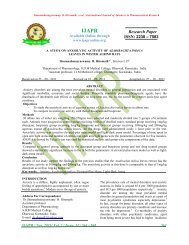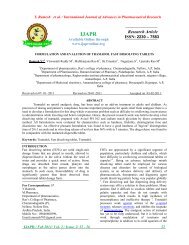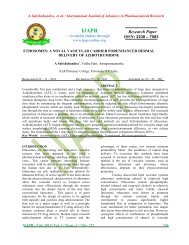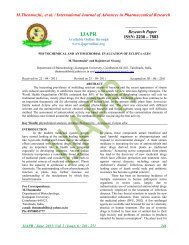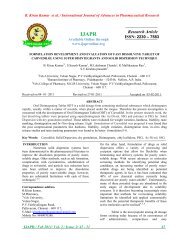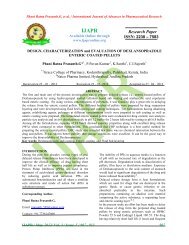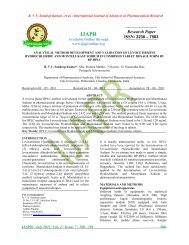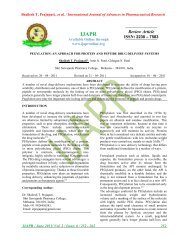formulation and characterizatin of transdermal patches by using ...
formulation and characterizatin of transdermal patches by using ...
formulation and characterizatin of transdermal patches by using ...
Create successful ePaper yourself
Turn your PDF publications into a flip-book with our unique Google optimized e-Paper software.
Venkata Subbaiah K.P., et al. / International Journal <strong>of</strong> Advances in Pharmaceutical Research<br />
IJAPR<br />
Available Online through<br />
www.ijapronline.org<br />
Research Paper<br />
ISSN: 2230 – 7583<br />
BIO-PROSPECTING AND DOCUMENTATION OF TRADITIONAL MEDICINAL<br />
PLANTS USED TO TREAT SELECTED SKIN DISEASESBY ETHNIC GROUPS OF<br />
KURNOOL DISTRICT, ANDHRA PRADESH, INDIA.<br />
Venkata Subbaiah K.P * <strong>and</strong> Savithramma N.<br />
Department <strong>of</strong> Botany, Sri Venkateswara University, Tirupati, Andhra Pradesh – 517502, India.<br />
Received on 17 – 11 - 2011 Revised on 21 – 12- 2011 Accepted on 30– 01 – 2012<br />
ABSTRACT<br />
WHO Promoting the herbal drugs because <strong>of</strong> its therapeutic potentials. The present paper aimed to document the<br />
wealth <strong>of</strong> medicinal plant species used <strong>by</strong> ethnic groups <strong>of</strong> Kurnool District to curing scabies, leucoderma, boils <strong>and</strong><br />
cuts skin diseases. It was found that all plant parts <strong>and</strong> their extracts used to treat scabies, leucoderma, boils <strong>and</strong><br />
cuts skin diseases skin disease. The information <strong>of</strong> plants used to treat these skin diseases from tribal people was<br />
collected <strong>and</strong> plant species were identified with the help <strong>of</strong> the floristic treatises <strong>and</strong> date was documented. The<br />
documented information was cross checked with Ayurvedic physicians. The results revealed that 21 plants species<br />
are <strong>using</strong> <strong>by</strong> people belonging to four ethnic groups. Among these 8 plant species used <strong>by</strong> ethnic groups to treat<br />
scabies, leucoderma, boils <strong>and</strong> cuts skin diseases are also prescribed <strong>by</strong> Ayurvedic physicians. Nationally four<br />
Ayurvedic companies are preparing 21 types <strong>of</strong> drugs <strong>and</strong> releasing in the market. Remaining 13 plant species<br />
should be explored for the safety <strong>of</strong> herbal preparation to cure scabies, leucoderma, boils <strong>and</strong> cuts skin diseases.<br />
These plants represent a major source for the pharmaceutical industries in a view <strong>of</strong> their raw material. The<br />
information will draw the attention <strong>of</strong> pharmacologists <strong>and</strong> phytochemists for further critical investigations.<br />
Keywords: Bio-prospecting, Medicinal plants, Scabies, Leucoderma, Ethnic groups.<br />
INTRODUCTION<br />
The relationship between man, plants <strong>and</strong><br />
drugs derived form plants described the history <strong>of</strong><br />
mankind. Since ancient times, people have been<br />
exploring the nature particularly plants in search <strong>of</strong><br />
new drugs. This has resulted in the use <strong>of</strong> large<br />
number <strong>of</strong> medicinal plants which curative properties<br />
to treat various diseases 1 . WHO encouraging the<br />
traditional drugs because <strong>of</strong> its less side effects <strong>and</strong><br />
matter <strong>of</strong> low cost, easy availability hence most <strong>of</strong><br />
the European countries exp<strong>and</strong>ing towards Ayurvedic<br />
medicines 2 . Now-a-days plant based drugs are widely<br />
used <strong>and</strong> many countries contributes 40-50% <strong>of</strong> their<br />
total health budget in the production <strong>of</strong> novel drugs 3 .<br />
Author for Correspondence<br />
K.P. Venkata Subbaiah<br />
Research Scholar<br />
Department <strong>of</strong> Botany<br />
S.V. University, Tirupati-517 502<br />
Chittoor (Dt), Andhra Pradesh, INDIA<br />
In India, drugs <strong>of</strong> herbal origin have been used in<br />
traditional systems <strong>of</strong> medicines such as Unani,<br />
Ayurveda, Siddha 4 . India is one <strong>of</strong> the worlds 12<br />
biodiversity centers with the presence <strong>of</strong> over 45000<br />
different plant species. Of these, about 15,000 to<br />
20,000 plants have gold medicinal value. Everyday<br />
new inspiring information is being added to folklore<br />
medicine for the development <strong>of</strong> drugs 5 .<br />
Ethnic groups have staunch confidence on<br />
medicinal plants for the treatment <strong>of</strong> scabies,<br />
leucoderma, boils <strong>and</strong> cuts skin diseases. Scabies is<br />
an itching skin disease caused <strong>by</strong> a mite. Leucoderma<br />
or vitiligo is skin disorder where the skin loses its<br />
normal colour. The occurrence <strong>of</strong> leucoderma about<br />
42% is stress related, 28% hereditary <strong>and</strong> 30% 6 .<br />
Ethnic groups was confounded that a small colored<br />
almost milky patch on the skin surface. Boils or<br />
furuncle is deep folliculated, infection on the hair<br />
follicle. It is caused <strong>by</strong> Staphylococcus aures,<br />
bacteria 7 . Boils are bumpy red, pus-field lumps<br />
around a hair follicle that are tender, warm <strong>and</strong> very<br />
IJAPR / Feb. 2012/ Vol. 3 / Issue. 2 / 790 - 797 790
Venkata Subbaiah K.P., et al. / International Journal <strong>of</strong> Advances in Pharmaceutical Research<br />
painful 8 . Despite <strong>of</strong> various studies that have been<br />
conducted on medicinal plants <strong>of</strong> Andhra Pradesh 9-15 ,<br />
India. The studies on medicinal plants to treat disease<br />
are scanty. Hence the present study was under taken<br />
to document the traditional use <strong>of</strong> plant species to<br />
treat scabies, leucoderma, boils <strong>and</strong> cuts skin<br />
diseases.<br />
The Kurnool Districts is one <strong>of</strong> the oldest<br />
<strong>and</strong> richest cultural traditions <strong>of</strong> <strong>using</strong> medicinal<br />
plants, which is located (14 0 54 1 <strong>and</strong> 16 0 11 1 NL; <strong>and</strong><br />
76 0 58 1 <strong>and</strong> 78 0 25 0 EL]; with the total geographical<br />
area <strong>of</strong> 18,799 km 2 in Andhra Pradesh, India 16 . The<br />
study area is inhabited <strong>by</strong> the ethnic groups <strong>of</strong><br />
Chenchu, Yerukala, Sugali (Lambadas) <strong>and</strong> Yanadi.<br />
The ethnic groups inhabited at the river bank <strong>of</strong> water<br />
streams in the forest posses fairly good knowledge<br />
about the medicinal properties <strong>of</strong> plants. Even<br />
though a number <strong>of</strong> reports are available on the<br />
ethnobotany <strong>of</strong> Kurnool District 17-25 , the detailed<br />
study on medicinal plants used to cure scabies,<br />
leucoderma, boils <strong>and</strong> cuts skin diseases is not<br />
reported so far. Therefore, an attempt has been made<br />
to record the medicinal plants used to treat scabies,<br />
leucoderma, boils <strong>and</strong> cuts skin disease from ethnic<br />
groups (traditional healers) <strong>and</strong> compared with<br />
Ayurvedic medicines which are available in the<br />
market. This study is most helpful <strong>of</strong> ethnobotanists,<br />
phytochemists <strong>and</strong> pharmacologists for validation<br />
<strong>and</strong> clinical studies, to explore the importance <strong>of</strong> left<br />
over medicinal plants which are only used <strong>by</strong> ethnic<br />
groups <strong>and</strong> not mentioned hitherto.<br />
MATERIALS AND METHODS<br />
An extensive field survey was carried out<br />
during 2010 to 2011 in the tribal belts <strong>and</strong> adjoining<br />
forest areas <strong>of</strong> Kurnool district to collect the<br />
information on medicinal plants used to treat scabies,<br />
leucoderma, boils <strong>and</strong> cuts skin diseases <strong>by</strong> ethnic<br />
groups Chenchu, Yerukala, Sugali <strong>and</strong> Y<strong>and</strong>i. The<br />
information was gathered on plants used to treat<br />
scabies, leucoderma, boils <strong>and</strong> cuts skin diseases<br />
mainly on plant part <strong>and</strong> time <strong>of</strong> collection from the<br />
field; preparation <strong>of</strong> medicine <strong>and</strong> type <strong>of</strong><br />
administration <strong>of</strong> the drug. All plants mentioned <strong>by</strong><br />
them to treat scabies, leucoderma, boils <strong>and</strong> cuts skin<br />
diseases were collected <strong>and</strong> identified with the help<br />
<strong>of</strong> the floristic treatises published <strong>by</strong> Gamble 26 ;<br />
Venkataraju <strong>and</strong> Pullaiah 27 . The information given<br />
<strong>by</strong> ethnic groups was cross checked with Ayurvedic<br />
physicians <strong>of</strong> Sri Venkateswara Ayurvedic Hospital,<br />
Tirupati, for authentication. Ayruvedic drugs are<br />
available in the market in various br<strong>and</strong>s in which 8<br />
plants mentioned <strong>by</strong> ethnic groups were included.<br />
Chi-square test was carried out to test the association<br />
<strong>of</strong> plant part used to scabies, leucoderma, boils <strong>and</strong><br />
cuts skin diseases.<br />
RESULTS AND DISCUSSION<br />
From the study area documented plants<br />
claimed to have medicinal value for the treatment <strong>of</strong><br />
scabies, leucoderma, boils <strong>and</strong> cuts skin diseases are<br />
presented in (Table-1). Scientific names <strong>of</strong> plants<br />
have been arranged alphabetically. The identified<br />
taxa are taxonomically analyzed <strong>and</strong> nomenclature is<br />
updated with the help <strong>of</strong> ICBN rules 28 . The plant<br />
species are followed <strong>by</strong> family name within the<br />
parentheses, vernacular name, plant part used,<br />
preparation <strong>of</strong> medicine, form <strong>of</strong> medicine <strong>and</strong><br />
therapeutic action are provided. The information is<br />
obtained for 23 plant species which are belonging to<br />
22 genera <strong>of</strong> 20 families.<br />
Among the plant parts <strong>of</strong> rhizome (4.76%)<br />
followed <strong>by</strong> tuber (4.67%), root (14.85%), leaves<br />
(28.57%), latex (4.76%), stem (4.67%), bark<br />
(9.52%), fruit (23.80%) <strong>and</strong> seed (4.67%) (Fig-1) are<br />
<strong>using</strong> in the preparation <strong>of</strong> medicine.<br />
Ayurvedic physicians <strong>of</strong> Sri Venkateswara<br />
Ayurvedic Hospital are prescribing the medicine to<br />
treat scabies, leucoderma, boils <strong>and</strong> cuts skin diseases<br />
<strong>by</strong> <strong>using</strong> ten different forms <strong>of</strong> drugs like Arista,<br />
Churna, Capsule, Lehya, Thailams, Savam,<br />
Yanakam, Pills, Syrup <strong>and</strong> Rasayana (Table-2). The<br />
total 21 plants species mentioned <strong>by</strong> ethnic groups to<br />
treat scabies, leucoderma, boils <strong>and</strong> cuts skin diseases<br />
8 plants species are including in the preparation <strong>of</strong> 21<br />
types <strong>of</strong> Ayurvedic drugs. These 21 types <strong>of</strong><br />
Ayurvedic drugs in different trade names<br />
Dasamoolarista, Triphala churna, Himstantim-P-Tab,<br />
Palasug<strong>and</strong>ha lehya, Neelithailam, Moolaka Savam,<br />
Hemipure, Madhusnuhirasayana etc. (Table-2) are<br />
releasing in the market <strong>by</strong> four Ayurvedic companies<br />
(manufactures) after clinical trails <strong>and</strong> getting<br />
approved from the Department Drug Control <strong>of</strong><br />
India.<br />
However remaining thirteen plant species<br />
are purely used <strong>by</strong> ethnic groups only. The results<br />
reveled that there is a significant association between<br />
scabies, leucoderma, boils <strong>and</strong> cuts skin diseases <strong>and</strong><br />
plant part (Table-3), (‘p’ value is 0.003
Venkata Subbaiah K.P., et al. / International Journal <strong>of</strong> Advances in Pharmaceutical Research<br />
medicine. Among 21 plants used <strong>by</strong> ethnic groups <strong>of</strong> Kurnool district for treating scabies, leucoderma,<br />
boils <strong>and</strong> cuts skin diseases only 8 plant species has been known to public, remaining 13 plant species<br />
should be explored for herbal preparation to cure for scabies, leucoderma, boils <strong>and</strong> cuts skin diseases<br />
skin diseases. Otherwise this traditional knowledge will slowly disappear due to lack <strong>of</strong> proper<br />
documentation <strong>and</strong> awareness. These plants represent a major source for the pharmaceutical industries<br />
in view <strong>of</strong> their raw material. Modern medical facilities are now making a rapid penetration into tribal<br />
villages, which may result in the disappearance <strong>of</strong> the herbal wealth. It is hoped the remaining 13<br />
plants species that this study will draw the attention <strong>of</strong> ethnobotanists, phytochemists <strong>and</strong><br />
pharmacologists for further critical investigations.<br />
ACKNOWLEDGEMENTS<br />
The authors are highly grateful to ethnic groups who shared their knowledge <strong>of</strong> plants for<br />
treating scabies, leucoderma, boils <strong>and</strong> cuts skin diseases <strong>and</strong> locating the plants in the field. Our<br />
thanks to Ayurvedic physicians Dr. B. Gnana Prasuna, Dr. B. Harinathachary, Dr. H. Datthathreya <strong>of</strong><br />
Sri Venkateswara Ayurvedic Hospitals, Tirupati, for their valuable discussions <strong>and</strong> clinical<br />
information.<br />
S.NO<br />
Table No. 1<br />
List <strong>of</strong> medicinal plants used to treat scabies, leucoderma, boils <strong>and</strong> cuts skin diseases in Kurnool<br />
District, Andhra Pradesh, India <strong>by</strong> Ethnic Groups<br />
SCIENTIFIC NAME AND<br />
FAMILY<br />
VERNACULAR<br />
NAME (TELUGU<br />
LANGUAGE)<br />
DISEASE<br />
PART<br />
USED<br />
MODE OF<br />
ADMINISTRATION<br />
1. Alangium salvifolium (L.f.) Wang<br />
(Alangiaceae)<br />
2. Andrographis echioides (L.) Less<br />
(Acanthaceae)<br />
3. Andrographis nallamalayana Ellis.<br />
(Acanthaceae)<br />
4. Anogeissus latifolia (Roxb. ex. DC)<br />
Wall. Ex<br />
Guill.&Perr.(Combretaceae)<br />
Ooduga Cuts Leaf Leaves along with egg albumin<br />
layer made into paste, bounded<br />
on cuts (only one time).<br />
Yeedipalu Cuts Leaf Fresh leaves crushed <strong>and</strong> made<br />
into paste, applied externally to<br />
cure cuts.<br />
Kachugadda Leucoderma Root 5 g <strong>of</strong> root (5 g) along with that<br />
<strong>of</strong> Anthroxanthum indicum<br />
L.(5g whole plant) ground,<br />
boiled with water decoction<br />
given orally (5 ml) for twice a<br />
day for 2 months to treat<br />
leucoderma.<br />
Chirumanu Scabies Bark Fresh stem bark crushed <strong>and</strong><br />
made into juice mixed with<br />
coconut milk, given (50 ml)<br />
orally once a day an empty<br />
stomach before going to bed.<br />
This process is repeated 2 weeks<br />
to cure scabies.<br />
5. Cadaba fruticosa L. (Capparidaceae) Vuttarasi chettu Leucoderma Leaf Fresh leaves ground into paste<br />
<strong>and</strong> applied as an external<br />
application on white spots on the<br />
skin to treat leucoderma.<br />
6. Calotropis procera (Ait). R.<br />
Br.(Asclepiadaceae)<br />
7. Cyanotis tuberosa (Roxb) Shult &<br />
Shult.f. (Commelinaceae)<br />
8. Dioscorea bulbifera L.<br />
(Dioscoreaceae)<br />
Jilledu Scabies Latex Latex mixed with caster oil,<br />
slightly warned <strong>and</strong> applied as an<br />
external application to treat<br />
scabies.<br />
Yeggogula gaddalu Boils Root Root dried, ground into powder,<br />
mixed with coconut oil <strong>and</strong><br />
applied externally to treat boils.<br />
Chedupattu dumpa Boils Tuber Dried tuber ground into powder<br />
(5g), mixed with buttermilk<br />
IJAPR / Feb. 2012/ Vol. 3 / Issue. 2 / 790 - 797 792
Venkata Subbaiah K.P., et al. / International Journal <strong>of</strong> Advances in Pharmaceutical Research<br />
(50ml) <strong>and</strong> given orally at<br />
morning times with an empty<br />
stomach for four weeks to treat<br />
boils.<br />
9. Elephantopus scaber L. (Asteraceae) Eddunaluka Scabies Root Dried roots (10 g) ground into<br />
powder, mixed with mustard oil,<br />
slightly warmed <strong>and</strong> applied to<br />
treat scabies.<br />
10. Entada rheedii Spr. (Mimosaceae) Adavichinta Scabies Stem Stem crushed <strong>and</strong> juice is<br />
applied externally to treat<br />
scabies.<br />
11. Helicteres isora L. (Sterculiaceae) Gubatada Scabies Fruit Fresh fruits made into paste <strong>and</strong><br />
prepared a pills <strong>of</strong> peanut size, 3<br />
pills are given ones a day for 15<br />
days to cure scabies.<br />
12. Holarrhena pubescens (Buch. Ham)<br />
Wall.ex G.Don.(Apocynaceae)<br />
Kolamusti Leucoderma Bark Dry stem bark ground, powder<br />
mixed with coconut oil <strong>and</strong><br />
applied on the white spots to<br />
treat leucoderma.<br />
13. Jasminum azorium L. (Oleaceae) Jazi Scabies Leaf Leaves made into paste <strong>and</strong><br />
applied as plaster to treat<br />
scabies.<br />
14. Ocimum tenuiflorum L.<br />
(Lamiaceae)<br />
15. Phyllanthus emblica L.<br />
(Euphorbiaceae)<br />
16. Scleria lithosperma (L.) Sw.<br />
(Cyperaceae)<br />
Tulasi Scabies Leaf Fresh leaves ground <strong>and</strong> paste is<br />
applied as an external application<br />
to treat scabies.<br />
Usirikaya Scabies Fruit Dried cotyledons (50 g) are<br />
boiled in coconut oil <strong>and</strong> the oil<br />
extract is externally applied<br />
thrice a day to treat scabies.<br />
Kahilu pulu Leucoderma Rhizome 10 g <strong>of</strong> the dried tuberous<br />
rhizome made into a paste with<br />
water is externally applied twice<br />
a day to treat leucoderma.<br />
17. Sphaeranthus indicus L. (Asteraceae) Bodasaramu Scabies Leaf Leaves along with those <strong>of</strong><br />
Coldenia procumbens L. Leaves<br />
(1:1 ratio) ground with lime <strong>and</strong><br />
applied as an external application<br />
to treat scabies.<br />
18. Strychnos nux vomica L.<br />
(Strychnaceae)<br />
19. Terminalia chebula Retz.<br />
(Combretaceae)<br />
20. Toddalia asiatica( L.) Lam.<br />
(Rutaceae)<br />
21. Tribulus terrestris L.<br />
(Zygophyllaceae)<br />
Musti Leucoderma Seed Dry seeds ground, made into ash,<br />
mixed with neem oil <strong>and</strong> applied<br />
as an external application to treat<br />
leucoderma.<br />
Karaka Scabies Fruit Fruit powder mixed with honey<br />
<strong>and</strong> given orally for 20 days to<br />
cure scabies.<br />
Konda mirapa Scabies Fruit Dried fruits mixed with stem<br />
bark <strong>of</strong> Cassia fistula L.(1:1<br />
ratio) ground <strong>and</strong> powder is<br />
made into decoction. 10 ml <strong>of</strong><br />
decoction is given twice a day<br />
for 7 days to cure scabies.<br />
Nela palleru Scabies Fruit Fruit pulp mixed with turmeric<br />
<strong>and</strong> applied externally to treat<br />
scabies.<br />
IJAPR / Feb. 2012/ Vol. 3 / Issue. 2 / 790 - 797 793
Venkata Subbaiah K.P., et al. / International Journal <strong>of</strong> Advances in Pharmaceutical Research<br />
S.<br />
No.<br />
Table 2- Medicinal plants used <strong>by</strong> ethnic groups <strong>and</strong> also listed in the preparation <strong>of</strong> Ayurvedic Drugs (Popular br<strong>and</strong>s released nationally in the market) to treat<br />
scabies, leucoderma, boils <strong>and</strong> cuts skin diseases<br />
Scientific name<br />
D.S.<br />
(64)<br />
d<br />
Form <strong>of</strong> drug<br />
Arista's Chruna CAP/TABLET Lehya Thailams Savam<br />
K.H<br />
(16)<br />
d<br />
SAD<br />
(24)<br />
d<br />
S.C.<br />
34<br />
d<br />
T.C.<br />
(3)<br />
d<br />
B.T.<br />
(7)<br />
a<br />
H.T.<br />
(10)<br />
a<br />
R.G.<br />
(7)<br />
a<br />
AL<br />
(22)<br />
d<br />
PAL<br />
(27)<br />
d<br />
Trade Name <strong>of</strong> the drug<br />
1 Andrographis echioides 1 1 2<br />
2 Calotropis procera 1 1<br />
3 Holarrhena pubescens 1 1 2<br />
4 Jasminum azorium 1 1<br />
5 Phyllanthus emblica 1 1 1 3<br />
6 Terminalia chebula 1 1 1 1 1 1 1 1 1 1 1 11<br />
7 Tribulas terretris 1 1 1 3<br />
8 Ocimum tenuifolorum 1 1 1 1 1 1 1 7<br />
Total 1 1 1 1 1 1 1 1 1 1 1 1 2 1 4 2 1 2 4 1 1 30<br />
AT<br />
(8)<br />
b<br />
DT<br />
(35)<br />
b<br />
NT<br />
(14)<br />
b<br />
PT<br />
(23)<br />
b<br />
ST<br />
(22)<br />
b<br />
M.S.<br />
(9)<br />
b<br />
S.S.<br />
(17)<br />
b<br />
Yana<br />
kam<br />
DY.<br />
(33)<br />
b<br />
Pill<br />
GP<br />
(52)<br />
b<br />
Syrup<br />
SH<br />
(4)<br />
c<br />
Rasa<br />
yana<br />
M.R.<br />
(25)<br />
d<br />
Total<br />
DS : Dasamoolarista RG : RG-tab ST : Satnadhara Thailam a, b, c & d are manufacturer <strong>of</strong> the drug<br />
KH<br />
SAD<br />
:<br />
:<br />
Khadiarista<br />
Saribaddyarista<br />
AL<br />
PAL<br />
:<br />
:<br />
Amruthabhallataka<br />
Lehya<br />
Palasugh<strong>and</strong>ha Lehya<br />
MS<br />
SS<br />
:<br />
:<br />
Moolaka savam<br />
Surasa savam<br />
a: Kerala Ayurvedic Ltd., Athani, Alura, Kochi, Kerala-683585, India<br />
b: Viadyaratnam Oshadhasala, Olluru, Thrissur, Kerala-683585, India<br />
c: Fours Lab, Achayyanagar, Hyderabad-500044, Andhra Pradesh,<br />
SC : Sudharsana churna AT : Ashtapathradi Thailam DY : Doorvadi yanakam<br />
India<br />
d: Imi's Pharmaceuticals Pvt. Ltd., Seetharamapuram, Vijayawada-<br />
TC : Triphala curna DT : Dharunaka Thailam GP : Gopech<strong>and</strong><strong>and</strong>i pill<br />
50002, India<br />
BT : Biogest tab NT : Neeli Thailam SH : Hemispure<br />
HT Hinstantim-P-Tab PT Paranthy<strong>and</strong>i Thailam MR Madhusnuhi Rasayana<br />
The number in the peranthesis indicates total number <strong>of</strong> ingreadients present in the <strong>formulation</strong><br />
IJAPR / Feb. 2012/ Vol. 3 / Issue. 2 / 790 - 797 794
Venkata Subbaiah K.P., et al. / International Journal <strong>of</strong> Advances in Pharmaceutical Research<br />
Chi-Square<br />
value=55.243**<br />
p-value=0.003<br />
Table No. 3<br />
SUMMARY OF CHI-SQUARE TEST<br />
DISEASE<br />
TOTAL<br />
PLANT PART Scabies Leucoderma Boils Cuts<br />
RHIZOME<br />
TUBER<br />
ROOT<br />
LEAVES<br />
LATEX<br />
STEM<br />
BARK<br />
FRUIT<br />
SEED<br />
- 1 - - 1<br />
0 4.76% 0 0 4.76%<br />
- - 1 - 1<br />
0 0 4.76% 0 4.76%<br />
1 1 1 - 3<br />
4.76% 4.76% 4.76% 0 14.85%<br />
3 1 - 2 6<br />
14.85% 4.76% 0 9.52% 28.57%<br />
1 - - - 1<br />
4.76% 0 0 0 4.76%<br />
1 - - - 1<br />
4.76% 0 0 0 4.76%<br />
1 1 - - 2<br />
4.76% 4.76% 0 0 9.52%<br />
5 - - - 5<br />
23.80% 0 0 0 23.80%<br />
- 1 - - 1<br />
0 4.76% 0 0 4.76%<br />
TOTAL 57.14 23.80 9.52 9.52 100%<br />
IJAPR / Feb. 2012/ Vol. 3 / Issue. 2 / 790 - 797 795
Plant part<br />
Venkata Subbaiah K.P., et al. / International Journal <strong>of</strong> Advances in Pharmaceutical Research<br />
Fig.1 Different plant parts used <strong>by</strong> Ethnic groups to treat these skin<br />
diseases<br />
100%<br />
90%<br />
80%<br />
70%<br />
60%<br />
50%<br />
40%<br />
30%<br />
20%<br />
10%<br />
0%<br />
Scabies Leucoderma Boils Cuts<br />
Seed<br />
Fruit<br />
Bark<br />
Stem<br />
Latex<br />
Leaves<br />
Root<br />
Tuber<br />
Rhizome<br />
Disease<br />
REFERENCES<br />
1. VerpoorteR., Chemodirversity <strong>and</strong> the<br />
Biological Role <strong>of</strong> secondary metabolites,<br />
same thoughts for selecting plant material<br />
for drug development. Proc. Phytochem.<br />
Soc. Europe 1998,43,11-24.<br />
2. WHO., General guidelines for<br />
methodologies as research <strong>and</strong> evaluation <strong>of</strong><br />
traditional medicine, Geneva, Switzerl<strong>and</strong><br />
2000, 71.<br />
3. SatiSC, SatiN, RawatU, SatiOP., Medicinal<br />
plants as a source <strong>of</strong> antioxidants. Res. J.<br />
Phytochems 2010, 4, 213-224.<br />
4. SatyavathiGV, GuptaAK, T<strong>and</strong>anN.,<br />
Medicinal plants <strong>of</strong> India, Indian council <strong>of</strong><br />
Medical Research, New Delhi, India. 1987.<br />
5. Cox P, BlackM., The Ethnobotanical<br />
approaches to drug discovery. Sci. Am 1994,<br />
82-87.<br />
6. Medicine plus Encyclopedia Furuncle.<br />
7. Medicine plus Encyclopedia Carbuncle.<br />
8. BlumeJE, LevineEG, HeymannWR.,<br />
Bacterial diseases in Bolo2001,gnia JL,<br />
Jorio JL, Rapini RP. Dermatology. Mos<strong>by</strong><br />
2003, 1126 (ISBN 0323024092).<br />
9. JeevanramA, AdinarayanareddyP,<br />
VenkatarajuRR., The medico-botanical<br />
studies on crude drugs for skin diseases used<br />
<strong>by</strong> tribal’s from Eastern Ghats <strong>of</strong> Andhra<br />
Pradesh, India. Biodiversity, Taxonomy <strong>and</strong><br />
conservation <strong>of</strong> flowering plants. 1999, 337-<br />
347.<br />
10. SavithrammaN, RaoKN., Biodiversity in<br />
medicinal plants health <strong>of</strong> Sriharikota,<br />
Andhra Pradesh. ISEP-21, 2001, 9, 811-815.<br />
11. SavithrammaN., Diversity <strong>and</strong> conservation<br />
<strong>of</strong> medicinal plants <strong>of</strong> Seshachalam hill<br />
range <strong>of</strong> Andhra Pradesh. Bull. Bot. Surv.<br />
India 2004, 46, 438-453.<br />
12. SavithrammaN, Sulochana., Endemic<br />
medicinal plants from Tirumala Hills<br />
Andhra Pradesh. Fitotherapia 1998 LXIX<br />
(3), 253-254.<br />
13. SavithrammaN, SudharshanammaD.,<br />
Endemic medical plant <strong>of</strong> Eastern Ghats,<br />
India. The Bioscan 2006, 1(1-4), 51-53.<br />
14. VenkatarathnamK, VenkatarajuRR.,<br />
Traditional medicine used <strong>by</strong> the Adivasis <strong>of</strong><br />
Eastern Ghats, Andhra Pradesh – for bone<br />
fractures .Ethanobotanical leaf lets 2008,<br />
12,19-22.<br />
15. RoutSD, P<strong>and</strong>aT, MishraN., Ethnomedicinal<br />
plants used to cure different<br />
disease <strong>by</strong> Tirbals <strong>of</strong> Mayurbhanj District <strong>of</strong><br />
North Orissa. Ethno-med 2001, 3(1), 27-32.<br />
16. Anonymous., H<strong>and</strong> book <strong>of</strong> Statistics. Chief<br />
Planning Officer, Kurnool, Andhra Pradesh,<br />
India. 1995.<br />
17. Ellis JL., Wild Plant resources <strong>of</strong> Nallamala<br />
on the Eastern Ghats <strong>of</strong> India. A preliminary<br />
list . Bull. Bot. Surv. India, 1982, 10, 140-<br />
160.<br />
18. RamaraoN, HenryN., The Ethnobotany <strong>of</strong><br />
Eastern Ghats in Andhra Pradesh, India.<br />
Botanical Survey <strong>of</strong> India, Calcutta. 1996<br />
19. Saiprasadgoud, PullaiahT., Folk Veterinary<br />
medicinal plants <strong>of</strong> Kurnool District, Andhra<br />
Pradesh, India. Ethnobot 1996, 8, 71-74.<br />
20. JeevanramA, VenkatarajuRR., Certain<br />
potential crude drugs used <strong>by</strong> tribal’s <strong>of</strong><br />
Nallamala, Andhra Pradesh, for skin<br />
IJAPR / Feb. 2012/ Vol. 3 / Issue. 2 / 790 - 797 796
Venkata Subbaiah K.P., et al. / International Journal <strong>of</strong> Advances in Pharmaceutical Research<br />
diseases. Ethnobotany 2001, 13(12), 110-<br />
115.<br />
21. Ramach<strong>and</strong>rareddyP, Padmarao P,<br />
PrabhakarM., Ethnomedicinal practices<br />
amongst Chenchus <strong>of</strong> Nagarjuna sagar<br />
Srisailam Tigar Reserve (NSTR), Andhra<br />
Pradesh – Plant remedies for cuts, wounds<br />
<strong>and</strong> boils. Ethnobot 2003, 15, 67-70.<br />
22. VenkataratnamK, VenkatarajuRR., Folk<br />
medicine from G<strong>and</strong>la brahmeswaram wild<br />
life sanctuary. Andhra Pradesh, India.<br />
Ethnobot 2004, 16, 33-39.<br />
23. VenkataratnamK, VenkatarajuRR., Folk<br />
Medicine used for common women ailments<br />
<strong>by</strong> adivasis in the Eastern Ghats <strong>of</strong> Andhra<br />
Pradesh, India. J. Trad. Knowled 2005, 4,<br />
267-270.<br />
24. GoudS, PullaiahT., Ethno-botany <strong>of</strong><br />
Kunrool District: some wild plants used as<br />
food. Journal <strong>of</strong> Economic <strong>and</strong> taxonomic<br />
botany, additional series 1996, 12, 224-227.<br />
25. Venkata subbaiah KP, SavithrammaN., Bioprospecting<br />
<strong>and</strong> documentation <strong>of</strong> traditional<br />
medicinal plants used to treat ringworm <strong>by</strong><br />
ethnic groups <strong>of</strong> Kurnool district, Andhra<br />
Pradesh, India. IJPPS 2012, 4(1), 251-254.<br />
26. GambleJS., Flora <strong>of</strong> the presidency <strong>of</strong><br />
Madras. Vol.1-3. Authority <strong>of</strong> the Secretary<br />
<strong>of</strong> State for India in Council, Dehra Dun,<br />
India. 1936, 5, 1597.<br />
27. VenkatarajuRR, PullaiahT., Flora <strong>of</strong><br />
Kurnool. Bishensingh Mahendrapal Sing,<br />
Dehra Dun. 1995.<br />
28. GreuterW., International Code <strong>of</strong> Botanical<br />
Nomenclature. Adopted at the fourteenth<br />
international botanical congress, Berlin,<br />
July-August. Konigstenin, Koentz Scientific<br />
Books. 1988, 328.<br />
IJAPR / Feb. 2012/ Vol. 3 / Issue. 2 / 790 - 797 797



